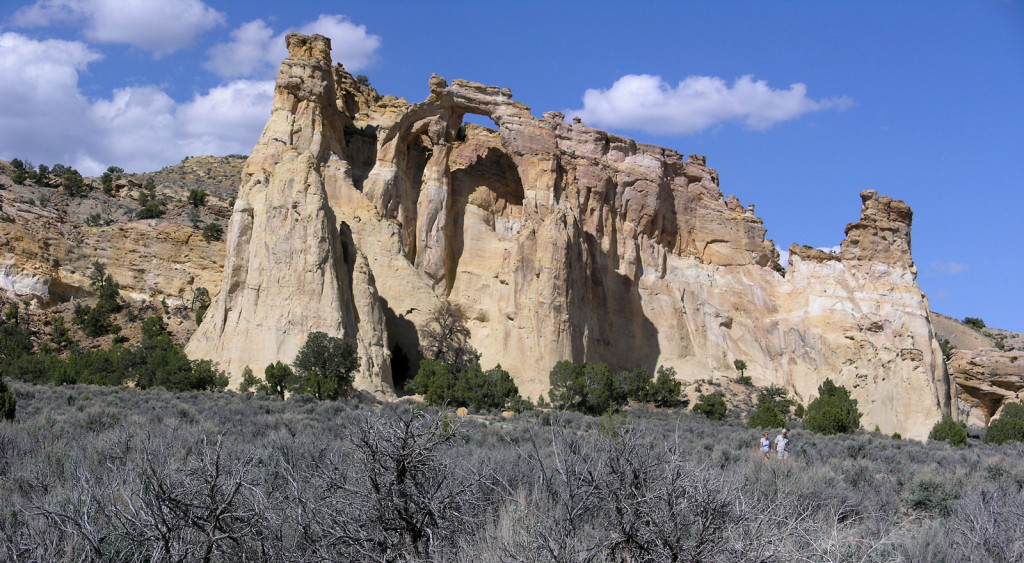
Grosvener Arch, a popular back-road destination in the Grand Staircase National Monument. Photo © Paul Levy.
The broad tilted terraces of the Grand Staircase step down through time. Some 200 million years of sedimentation are visible here, starting with pink in the north, then traveling through gray, white, and vermilion cliffs. Forces within the restless plateau have also buckled and folded rock layers into great reefs as long as 100 miles. Weathering then carved them into rainbow-hued rock monuments.A freshwater lake deposited the limey siltstones that became the Pink Cliffs (see these same rocks in Bryce Canyon National Park). This layer formed on top of the shale of the Gray Cliffs, deposited when an ocean covered the area; the Gray Cliffs step is rich with marine fossils and coal, formed from ancient wetland plants. The next older step, the White Cliffs, is composed of Navajo sandstone, one of the main rocks seen in Zion National Park. The bottom step, the bright Vermilion Cliffs, visible around Kanab, is also sandstone, laden with fossils of fish and dinosaurs. At the base of the whole staircase, the striped brick-colored Chinle badlands form the bed for the Paria River.These sandstone steps are stacked like pancakes. As in much of the Colorado Plateau region, erosion by water and wind produces amazing geological displays, including the intricate network of deep canyons, uplifted plateaus, sheer cliffs, beautiful sandstone arches and natural bridges, water pockets, sandstone monoliths, pedestals and balanced rocks, domes, and buttes.
About 300 million years ago, this land was at times a great Sahara-like desert, with dunes towering hundreds of feet high. At other times the land sank below sea level and was covered by water. Thick layers of sediment built up, one on top of the next. During the last 50 million years, powerful forces within the earth slowly pushed the entire region one mile upward. The ancestral Colorado River began to carve the deep gorges seen today at the Grand Canyon. In turn, the tributaries of the Colorado, such as the Escalante River, were trenched deeper and deeper in order to drain their watershed.
The most characteristic rocks in the monument are the ancient dunes turned to stone, called slickrock. They make up many of the sheer canyon cliffs, arches, and spires of the region. Delicate cross-bedded lines of the former dunes add grace to these features. Forces within the restless plateau have also buckled and folded rock layers into great reefs as long as 100 miles. Weathering then carved them into rainbow-hued rock monuments. The aptly named Cockscomb, visible from Cottonwood Canyon Road, which cuts through the center of the monument, is an example of these massive rock wrinkles.
The dry conditions and thin or nonexistent soils limit both plantlife and wildlife in the Escalante region. Annual plants simply wait for a wet year before quickly flowering and spreading their seeds. Piñon pines, junipers, and other plants often adapt by growing in rock cracks that concentrate moisture and nutrients. Small mammals such as mice, wood rats, rock squirrels, and chipmunks find food and shelter in these outposts of vegetation. Even meager soils permit the growth of hardy shrubs like blackbrush, greasewood, sagebrush, rabbitbrush, and Mormon tea. Prickly pear and other types of cacti also do well in the desert.
Perhaps the most unusual plant communities are the cryptobiotic crusts found on sandy soils. Mosses, lichens, fungi, algae, and diatoms live together in a gray-green or black layer up to several inches thick. Microclimates surrounding canyon seeps and springs provide a haven for hanging gardens of grasses, ferns, orchids, columbines, mosses, and other water-loving plants. River and stream banks have their own vegetation, including river willows, cattails, tamarisks, and cottonwoods.
Wildlife that you might see in the semiarid desert are mule deer, desert bighorn sheep, pronghorns, coyotes, bobcats, foxes, skunks, porcupines, and many species of rodents. Ravens, eagles, hawks, owls, falcons, magpies, and smaller birds fly overhead. Watch out for poisonous rattlesnakes and scorpions, although these shy creatures won’t attack unless provoked.